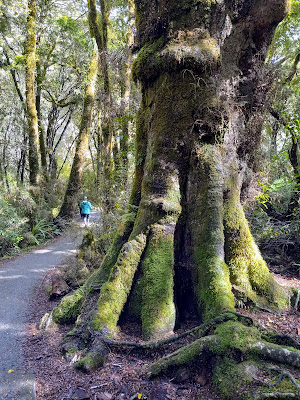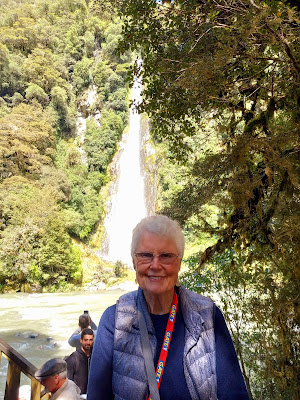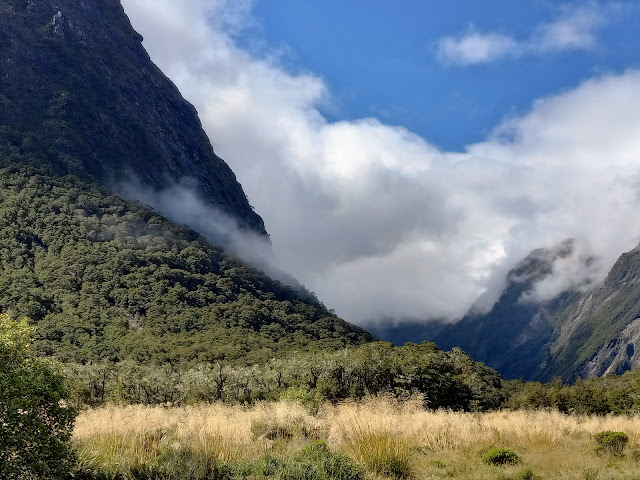New Zealand here we come...
I left behind snow, said good-bye to Nick on his 2-year mission in Baltimore (Spanish-speaking), and ESL classes for 2 weeksAnd, permanently, to the old BYU arts building where generations have enjoyed concerts and plays, etc. (The new center will open soon??)
And flew with my long-time friend Marilyn Johnson, to Auckland, New Zealand, "City of Sails"(1/4 of the population owns a boat!) with 1.4 million people, 2/3 on the north island, where 90% of the Maoris live. The Star Tower has been the tallest free-standing structure in the s. hemisphere. Is it still??We really enjoyed the War Memorial museum, built on one of 55 ancient craters in Auckland. Its Maori ceremonial and meeting houses, clothing, carvings, and artifacts are exquisite. Everything is built to honor their ancestors. and has spiritual significance. The Maoris, descendants of Polynesians, who arrived from the Cook and Sandwich Islands around 1300, bringing with them the rat, dog kuri which became extinct after Europeans arrived, root vegetables (taro and kumara, the sweet potato) and more. Around 1500, they built fortified sites to defend themselves. Their canoes, waka, have beautifully carved prows. Captain Cook arrived in 1769, on a scientific voyage to observe the transit of the sun by the planet Venus. Following Cook's 3 voyages there, the few Europeans who came worked as whalers, sealers, and timber traders. Permanent immigrants, mostly middle and working classes, and not convicts as in Australia, did not come until the mid-1800's when gold was discovered. NZ became a Dominion in 1907. We walked past the beautiful old railway station and ferry building, from which we took a short ferry ride. River beds carved by ancient glaciers have so many strands of water that they look braided sometimes.
Monday, March 4, we went by bus through the fertile Waikato Plains to the Waitamo Caves. From our metal boat through the dark caves we watched the 1000's of glow worms twinkle from the ceilings, with stalactites and stalagmites in shawl-like formations. Glowworms glow because they are hungry. Males live only 3 days, long enough to mate!
We continued on to Rotorua through the rich volcanic farmland which supports grain and other produce. Dairy cows (6 million) are the chief industry on the north island. Grass is the no. 1 asset of NZ, where cows (mostly on the north island) and sheep (the latter more on the s. island) always live in the open fields, never in barns. There are no predators and the weather is generally mild. There is 1 acre per cow. The average cow drinks 60 liters of water per day. 95% of the milk produced is exported.
In Rotorua, the north island's top tourist destination, and center of Maori culture, we visited the Botanical Gardens. With the area's many bores and fissures which give off the rotten egg smell of hydrogen sulfide, it became (and continues to be) a huge spa center in Victorian times. Our guide and tour manager Kevin Pilbrow is very well organized, attentive, informed, kind and funny. Our nice Gate 1 tour group of 20 (all from the US) laughed our way through New Zealand. 
A highlight of our trip was a delicious dinner hosted by Randall and Tina Leach. Because the language and culture were becoming lost, the Leaches, who are teachers, and others have formed schools and activities to teach the young what their Maori parents did not pass on to them. They are wonderful people and community leaders. They generously shared their culture with us. Randall is a school director, successful artist, and he and a daughter are medal-winning dancers. His wife is a teacher and dance assistant.We also tried Tip Top hokey pokey (vanilla with caramel, toffee and honey) ice cream, famous for the past 130 years, and "pavlova," a meringue and whipped cream dessert, after a delicious meal with them. Because Marilyn and I were unable to get tickets for the famous Hobbiton (Lord of the Rings) film location excursion, we had to settle for a duck ride on a lake! So sad!
Huka Falls with so much water (200,000 liters per minute plunge 9 meters) Everywhere we went we saw devastation from February's cyclone...tremendous wind and waterI was thrilled to visit the beautiful coastal redwood forest in Rotorua, planted in 1901. Everything grows fast here!The silver fern is a symbol of New Zealand. The Maori used the silver (the underneath side) to mark the way home at night).The highest Mountain on the north island: Mt. Ruapehu (2797 m)Wellington is known for its gumboots. Steve was able to thrown his the farthest so won a package of pineapple lumps! Lovely dinner at the oldest restaurant/bar: the Ambrosia. NZ's most famous writer, Katherine Mansfield's, photo was on the wall.Tuesday evening we enjoyed an authentic Hangi dinner, cooked in the steaming ground and Maori show, after an interesting visit to the Maori Arts and Crafts Institute and walk around the Whakarewarewa Thermal Village, and the Pohutu ("Big Splash") the largest geyser, which erupts 30 meters, 10-25 times/day. These dancers are performing the "Haka" or Challenge. It is used to frighten enemies and to prepare warriors. The tongue is always protruding. Tops are woven and skirts are made of rolled and dyed flax which grows everywhere.
Wednesday we drove south to the Wai-O-Tapu Thermal Park with its steaming geysers and bubbling hot springs.Unfortunately we were not able to travel to Hawkes Bay and Napier with its vineyards and art-deco architecture, because of the recent February 17, 2023 cyclone with its flooding which wiped the city off the map and did widespread damage throughout the area.
In Wellington, NZ's capital, known also as the "culinary capital," we did a food tour: seafood and produce markets, chocolate and beer factories, and finished with gelato.
Wellington, in many ways reminiscent of San Francisco, CA (hills, row and Victorian houses, waterfronts) has a an amazing museum, Te Papa Tongarewa with Maori, natural and military history.
The moa is the large extinct ancestor of the kiwi bird
We rode the 1902 (in 1933 it was electrified) cable car, built to link city with new hill suburbs, up the hill.
Thursday morning we flew to the expensive but very livable "garden city" Christchurch on the s. island. Much of the city, which is very "English" was destroyed or needs to be seismologically redone after the 7.1 2010 earthquake. 30,000 people came to help.The US and New Zealand are great allies. During the 9/11 terrorist attacks, many NZ firefighters came to help. A large girder from the 102nd floor was brought to Christchurch to commemorate our solidarity.
From Christchurch we took a small train across the flat Canterbury Plains ascending through the river gorges towards the southern Alps.We got off at Arthur's Pass and drove by bus to Hokitika on the Tasman Sea (1000 miles from Australia) for lunch
We had to share the road with many "MAMILS" (middle-aged men in lycra) along the way. Fortunately
our driver Viktor was excellent. There are many one-lane bridges. Arrows painted on the road showing the correct direction (NZers drive on the left) of traffic have reduced accidents by 70%.
Poor weather curtailed the helicopter flights some had hoped to take to Franz Josef Glacier. Deer are domesticated for venison We visited a kiwi bird sanctuary. Eggs are brought here, hatched and returned to the breeding ground when old enough to survive in the wild. There are 5 species of Kiwis. They are all nocturnal, flightless and found only in NZ. They belong to the same Ratite family as the ancient moa, the ostrich and emu. They are honorary mammals because they are ground-dwelling, have marrow-filled bones, body-temperatures of 37.8 degrees celcius (other birds 39-42), and a strong sense of smell. The kiwi is the only
We visited a kiwi bird sanctuary. Eggs are brought here, hatched and returned to the breeding ground when old enough to survive in the wild. There are 5 species of Kiwis. They are all nocturnal, flightless and found only in NZ. They belong to the same Ratite family as the ancient moa, the ostrich and emu. They are honorary mammals because they are ground-dwelling, have marrow-filled bones, body-temperatures of 37.8 degrees celcius (other birds 39-42), and a strong sense of smell. The kiwi is the only bird to have its nostrils at the end of its beak. They are monogamous, start breeding at 4-5 years, and have eggs up to 20% of female's body weight. That's comparable to a human giving birth to a 6 year old child! The male does most of the incubation (80 days) and chicks hatch fully feathered and are independent at 2 weeks!
A kiwi's main predator is the stoat. The kiwi can defend itself with its sharp claws and strong legs, and can outrun a human. The next morning in Franz Josef we did a nature walk, always hoping that we could see the mountains with glaciers.
We saw the Tasman Sea and lots of gorgeous scenery on the long drive to Queenstown.
Another stop with a waterfall
We loved crossing the Crown range and stopping at long Lake Harwea and Lake Wanaka, (where some of Lord of Rings shot)
To Queensland we took a steep, winding road stopping in the gold rush town of Arrowtown, which supposedly did not allow a bus of our size to travel. It was spectacular!
Coming down into Queenstown was breathtaking!This is the view of Lake Wakatipu from our window in Queenstown (named for Victoria)
We took a scenic cruise across Lake Wakatipu aboard the vintage steamship TSS Earnslaw (built in 1912, same year as the Titanic) to Walter Peak Country Farm, where we had our most delicious lunch, and celebrated Betty's birthday.
After lunch we watched a sheep being shorn and also enjoyed seeing the amazing border collies herding the sheep
Did you know that sheep: have peripheral vision that covers 270-320 degrees (humans have 100 degrees);
are emotionally complex, feeling fear, anger, boredom, sadness, happiness;
the wool of some never stops growing ??
We rode the gondola up the steep hills of Queenstown with spectacular views of the lake and Remarkables MountainsSome of our group did the luge run at the topThe next day, sadly our last, we departed Queenstown for Te Aneu and Fiordland National Park. Our guide Kevin with the family group of 8We stopped at Mirror Lakes, so lovely!In spite of the weather, Milford Sound was amazing!
What a gorgeous, fun, and unforgettable trip! We returned to fly from Queenstown to Auckland, then to LAX and me, home to Utah.
A fond farewell to new friends and a beautiful, clean, friendly, slower-paced country. If you need a good laugh and view of the NZ bush country, watch "Hunt for the Wilderpeople" I ate well, but I hope it's just the camera angle!!!Home to the cold, after a long 3-legged flight!





































































































































































